
Feature Article
Glycidyl Esters in Edible Fats and Oils and Infant Formula
In recent years, overseas studies revealed that glycidyl esters (GEs) were found in foods containing refined vegetable fats and oils, including margarine, bakery and pastry products, deep-fried products, various snack products, as well as infant formula and follow-up formula.
GEs Is an Emerging Food Safety Issue
GEs are process contaminants formed mainly during deodorisation in the refining of vegetable oils. After ingestion, GEs are broken down in the human body to release glycidol.
Glycidol is a genotoxic carcinogen classified as a group 2A agent (i.e. probably carcinogenic to humans) by the International Agency for Research on Cancer based on sufficient evidence in experimental animals. It may also have toxic effects on the nervous, renal and reproductive systems in experimental animals.
Risk Assessment Study
To examine the GE levels in fats and oils as well as infant formula available in the local market, the Centre for Food Safety (CFS) completed a risk assessment study on GEs in edible fats and oils and infant formula in July 2020.
A total of 207 samples, including 169 samples of edible fats and oils (covering palm oil, canola oil, corn oil, peanut oil, soybean oil, sunflower oil, other vegetable oils, butter, lard, margarine, spread and shortening) and 38 samples of infant formula, were tested for GEs.
Results of the study showed that the GE levels in edible fats and oils ranged from 16 µg/kg to 4,500 µg/kg*, with a mean level of 569 µg/kg. As for infant formula, the GE level detected ranged from 3.1 µg/kg to 53 µg/kg, with a mean level of 10.6 µg/ kg.
International Comparison
The mean GE levels in both the edible fats and oils samples and infant formula samples collected in the study were lower than the findings of similar studies by the European Food Safety Authority as well as New Zealand Food Safety and Food Standards Australia New Zealand. In addition, the upper ends of the range of GE levels in both the edible fats and oils samples and infant formula samples collected in the study were lower compared with the other two studies.
Further Findings
Reduction of GEs in refined oils and their products is possible when traders enhance their awareness on the issue and adopt relevant mitigation measures. A decreasing trend of GE levels in these foods is expected when food safety authorities and food traders worldwide develop an increased awareness of GEs following the recommendations of the Codex Alimentarius Commission (Codex) released in 2019.
In fact, a signal of decrement on the GE levels in foods was observed when some locally available follow-up oil samples were retested in 2020. It showed a reduction of more than 40% in most samples compared with the GE levels of the same products collected from late 2018 to early 2019.
Advice to Consumers
-
Members of the public are advised to maintain a balanced and varied diet to avoid excessive exposure to any contaminant from a small range of food items. In general, maintaining a healthy diet of lower fat content can reduce the overall intake of GEs from food.
- As breastfeeding is beneficial to the health of both mothers and their babies, mothers are encouraged to feed their babies with breastmilk. If infants are not breastfed, they should continue to be fed with infant formula to ensure optimum nutrition.
* Unless otherwise specified, the GE levels listed are upper bound values.
Readers' Corner
Calcium Oxalate — Stinging Crystals in Plants
In August 2020, a suspected food poisoning case related to calcium oxalate raphides occurred in Hong Kong. In fact, among the plant poisoning cases referred to the Toxicology Reference Laboratory of the Hospital Authority from 2003 to 2017, around one-fourth were related to calcium oxalate raphides. What is calcium oxalate? Why does it hurt?
Why Does Calcium Oxalate Hurt?
Many plants contain oxalates. Some oxalates, such as sodium and potassium oxalates, are water soluble, while others like calcium and magnesium oxalates form insoluble crystals. Calcium oxalate crystals have been found in more than 200 plant families and in almost all types of tissues of these plants, including leaf, stem, root and even anther.
Calcium oxalate crystals are found in several shapes in plants. There are needle-shaped “raphides”, pencil-shaped “styloids”, block-shaped “crystal sand” and rosette-shaped “druses”. Among them, needle-shaped raphides call for the greatest clinical attention.
Sharp needle-shaped raphides are packed in bundles within plant cells. Damage to the plant cells during chewing causes water to enter the cells and make them swell. This stimulates forceful propulsion of sharp raphides into the oral environment, which will stab the sensitive tissues of the tongue, gums and throat and result in tissue injuries in the oral cavity.
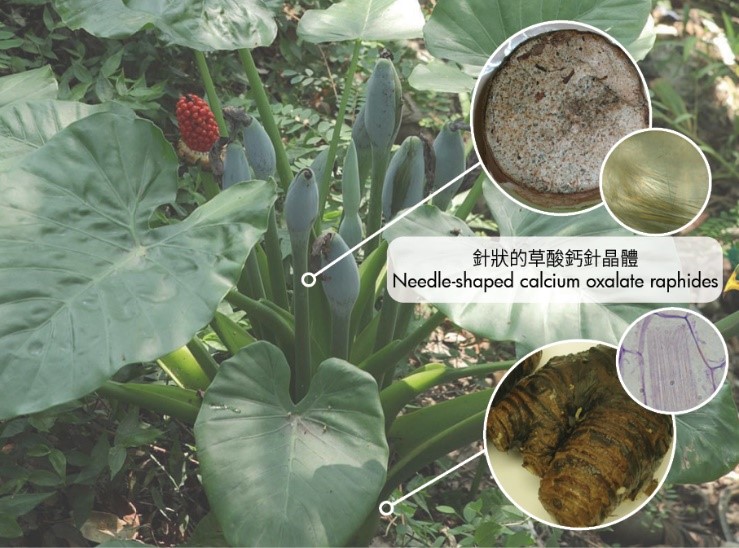
Figure 1: Microscopic examination of calcium oxalate raphides in the stem and corm of wild taro (courtesy of the Toxicology Reference Laboratory, Hospital Authority)
Some Calcium Oxalate Crystals Are Less Irritating
It is believed that the needle-shaped calcium oxalate is the most irritating, while calcium oxalate in other shapes are less likely to inflict damage. The calcium oxalate crystals of wild taro are needle-shaped and those of spinach are block-shaped. Therefore, although calcium oxalate crystals are present in both wild taro and spinach, only the crystals in wild taro can cause agonising irritation, whereas those in spinach have little effect.
The shape of calcium oxalate crystals mainly contributes to the irritating effect, but other factors also need to be considered. For example, the presence of enzymes in some plant cells that facilitate the breakdown of proteins may further potentiate the irritation through triggering an inflammatory reaction. Some raphides even have grooves which hold these enzymes. This is why the acrid taste of raw edible taro is substantially reduced after cooking, as cooking destroys the enzymes. However, cooking cannot remove the poisoning effect of wild taro and it should not be consumed.
Calcium Oxalate Poisoning
The symptoms of calcium oxalate poisoning are mainly localised with oral and sometimes upper airway irritation. Systemic absorption of the chemical is nevertheless rare, as the instantaneous pain and swelling of the mouth caused by raphides will usually stop the affected person from further ingesting a significant quantity of the plant. Rapid and immediate at the onset, these symptoms are mild in most cases, usually resolving within a short period of time.
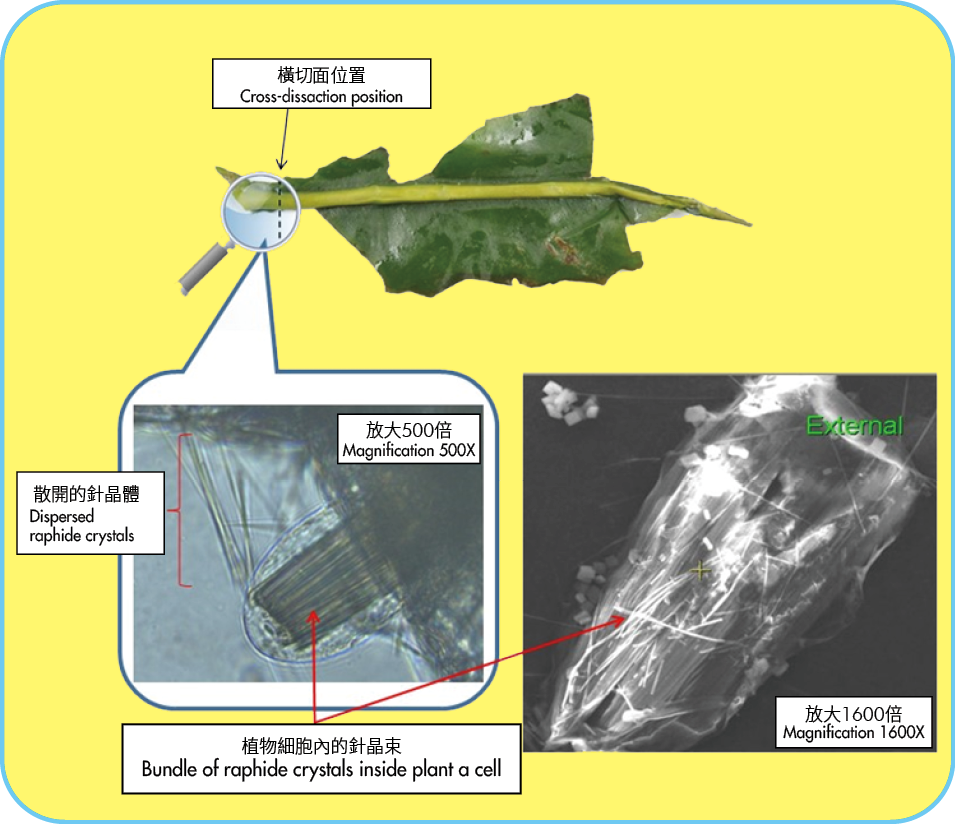
Figure 2: Microscopic examination of a leaf sample from a food complaint case showing the presence of calcium oxalate raphides in the sample (courtesy of the Government Laboratory)
Suspected Food Items Related to Calcium Oxalate Raphide Poisoning
In Hong Kong, previous food poisoning cases associated with calcium oxalate raphides mainly involved the consumption of wild taro, which is known to contain calcium oxalate raphides. Other cases involved different types of vegetables, such as water spinach, Chinese white cabbage, Chinese flowering cabbage and watercress. These vegetables are not supposed to contain calcium oxalate raphides, and it is postulated that the vegetables might have been mixed with small amounts of raphide-containing plants. In some of these incidents, leaves of wild taro might have been used to wrap or cover vegetables during transportation and processing of the vegetables.
Prevention
Calcium oxalate crystals are insoluble in water and heat resistant. Therefore, washing and cooking cannot reliably remove calcium oxalate from the toxic plants. The most effective way to prevent calcium oxalate poisoning is not to consume plants that are not known to be edible, and to avoid their contamination of edible vegetables.
Key Points to Note
- Some plants (e.g. wild taro) are known to contain needle-shaped calcium oxalate raphides and should not be consumed.
- Upon ingestion, calcium oxalate raphides will cause tissue irritation and pain in the mouth.
- Washing and cooking cannot reliably remove calcium oxalate raphides from plants.
Advice to Consumers
- Never pick and eat wild plants such as wild taro, as they could be poisonous.
- Buy vegetables from reliable suppliers.
- Remove any unidentified plants and objects mixed with the vegetables.
- If you feel unwell after food consumption, seek medical attention immediately, bringing along any food remnant.
Spot Check
Join Efforts to Uphold Food Safety of Food Delivery
Background
Amid the on-going COVID-19 epidemic, food delivery from food premises is becoming more popular. With the advance of mobile applications and technology, food orders can be easily made at our fingertips. However, there are many steps in food handling from the kitchen to the customers’ table. This raises public concern about the food safety risks involved in the food delivery service, including the lack of suitable temperature control and the risk of cross-contamination throughout the delivery process. It is necessary for food operators, delivery staff and customers to join hands to ensure that the delivered food is safe for consumption.
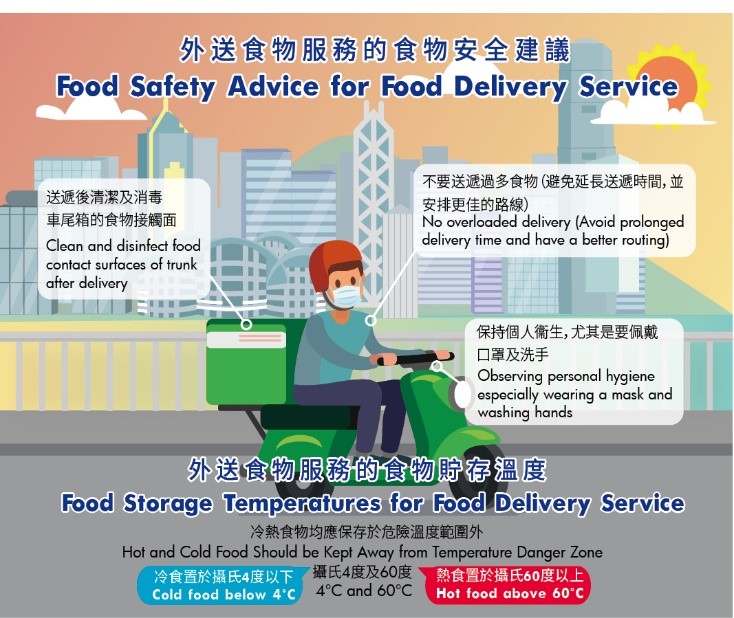
Figure 3: Proper hygienic practices and temperature control for food delivery
Food Safety Risks of Food Delivery from Restaurants
It is not uncommon for food operators to prepare food in advance to cater for a surge in demand during peak hours. Partially processed ingredients or cooked meal boxes will be set aside for some time before reheating and packing for delivery. The longer the time of food preparation and delivery and consumers’ deferred consumption, the higher the risk of the growth of food-poisoning bacteria in food within the temperature danger zone (between 4°C and 60°C). Besides, distorted and improperly sealed packaging, inadequate thermal insulation of food containers and unhygienic handling (such as food being tampered with by contaminated hands or altering the packaging) in the course of food delivery will also incur risks of cross-contamination of food.
Tips for Safe Food Delivery
While advanced food delivery mobile applications enable food caterers to take more orders from scattered locations, food caterers and delivery agents should pay heed to monitoring the hygienic practices of their staff during food storage and delivery. For the food delivery service, Hazard Analysis Critical Control Point (HACCP) plans or HACCP-based food safety systems are well-recognised and effective tools to systematically analyse and identify possible control points against different food hazards from food preparation, packing and storage to the final delivery. The risk control points should focus on food hygiene in food preparation, food temperature control and maintenance of cleanliness of all food contact surfaces during delivery.
Advice to Consumers
- The public should place orders for an appropriate amount of food from reliable suppliers or catering premises of close proximity to avoid long-haul delivery.
- Consumers should order thoroughly cooked food when using food delivery service.
- Delayed delivery or food with noticeable packaging defects should be rejected.
- Consume delivered foods immediately. Leftovers should be properly and quickly cooled and put into the refrigerator within two hours.
Updates on CFS
Food Safety Day: Eat Safe! Know Your High-risk Foods
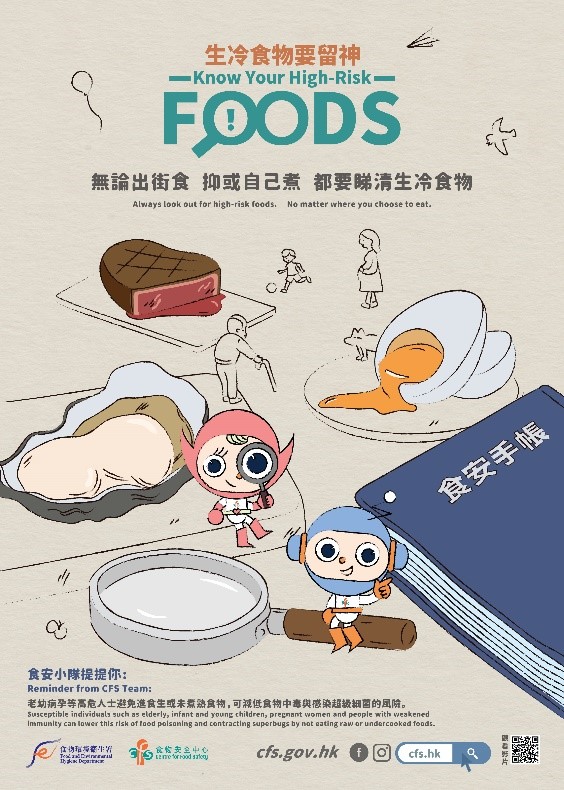
The CFS has adopted “Eat Safe! Know Your High-risk Foods” as the theme of Food Safety Day 2020. The aim is to draw public attention to the health risks of “raw and cold food” (a loose description of raw or undercooked foods) to four susceptible groups, namely pregnant women, infants and young children, the elderly and people with weakened immunity.
The health risks posed by “raw and cold food” to pregnant women and infants and young children were discussed in the previous issue. In this issue, we will focus on the elderly and people with weakened immunity.
The Elderly
Our body’s natural defences will become progressively weaker as we are getting old. Some elderly people may find their immune systems further weakened if they suffer from certain chronic diseases (e.g. diabetes) or are receiving treatment for such diseases.
People with Weakened Immunity
People with weakened immunity include those with immunological disorders (e.g. HIV infection) or chronic diseases (e.g. cancer) and patients undergoing immunosuppressive treatments (e.g. taking medicines to prevent transplant rejection). These people are more susceptible to food-borne diseases and their complications with the consumption of “raw and cold food”.
“Know Your High-risk Foods” Leaflets
- Food Safety Advice for Infants and Young Children
- Food Safety Advice for Pregnant Women
- Food Safety Advice for the Elderly
- Food Safety Advice for People with Weakened Immunity
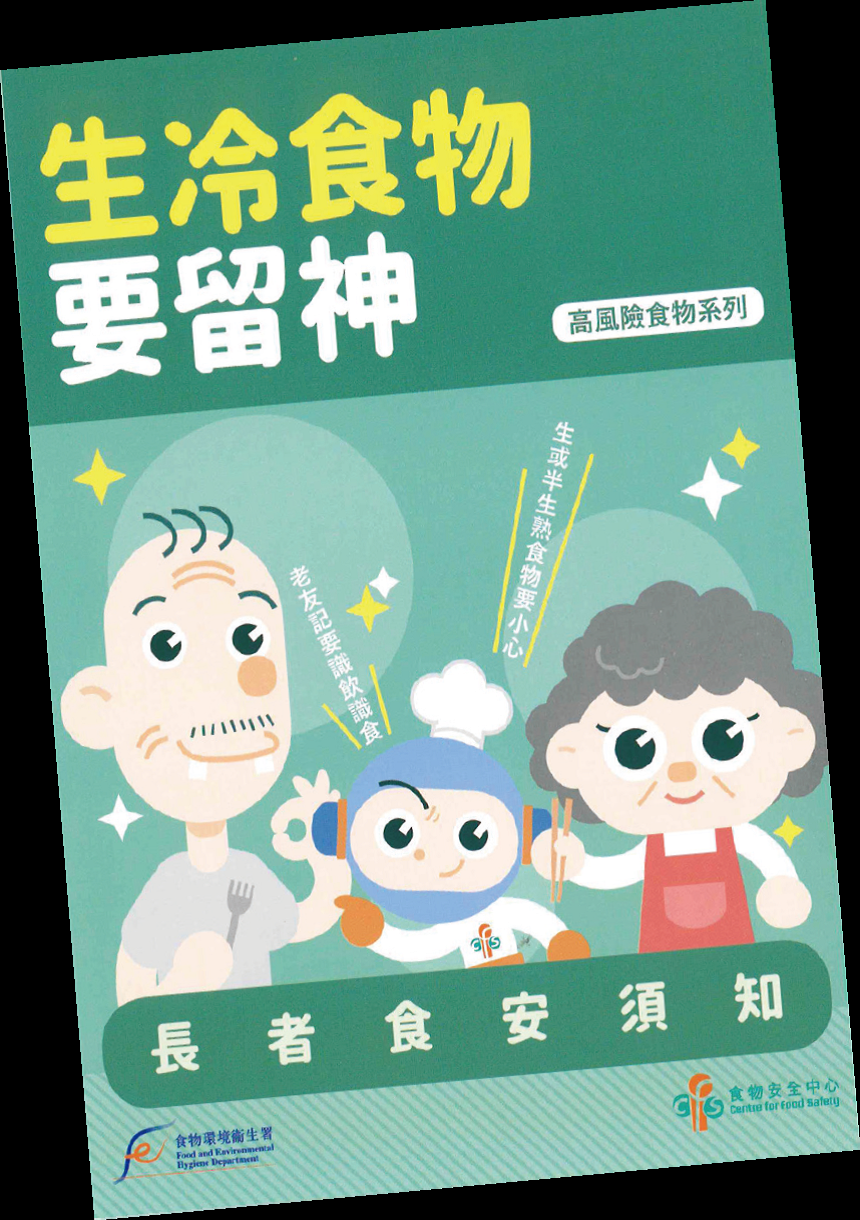
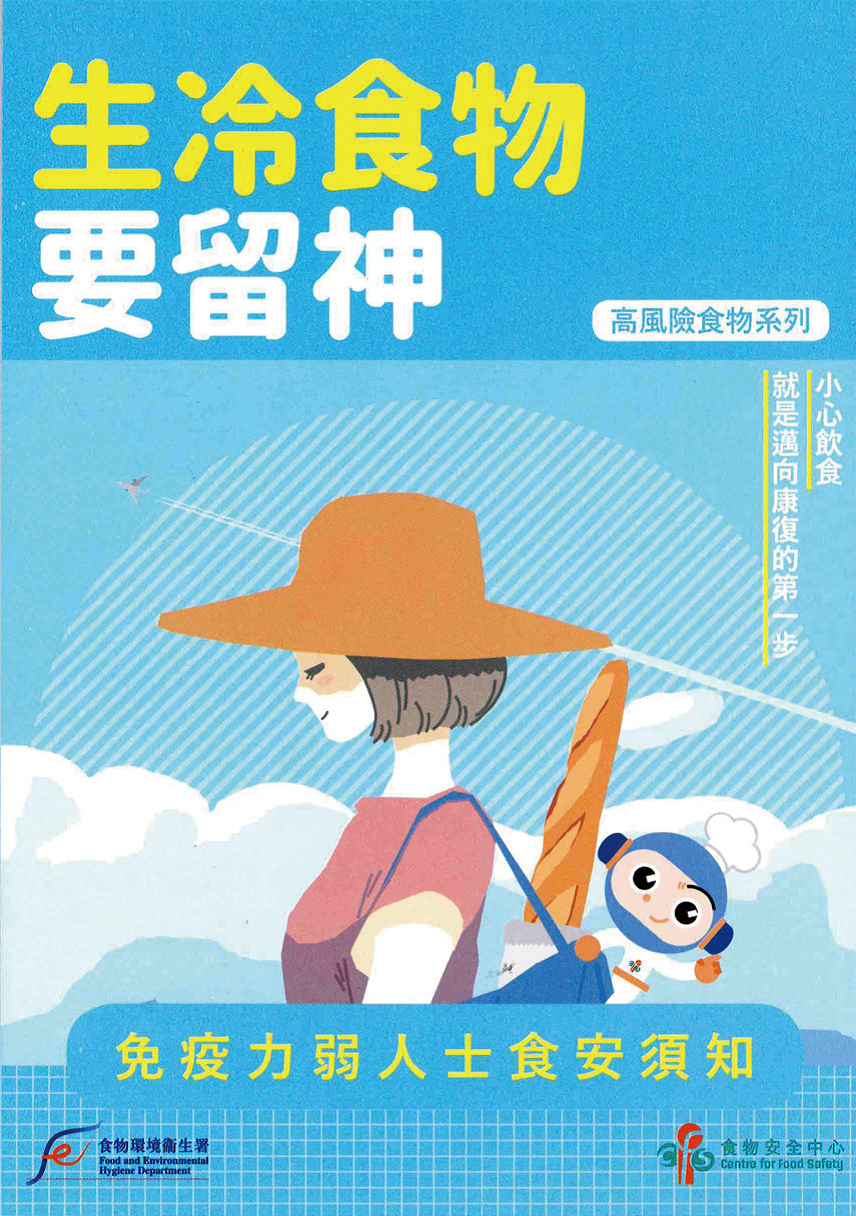
For more information, please visit the following webpage:
http://www.cfs.gov.hk/foodsafetyday/

Free copies of the leaflets are available at the Communication Resource Unit at Room 401, 4/F, Food and Environmental Hygiene Department Nam Cheong Offices and Vehicle Depot, 87 Yen Chow Street West, Sham Shui Po, Kowloon.
“EatSafe: CFS Channel” ― A New Online Video Campaign on Food Safety
Food safety awareness is on the rise in Hong Kong. The number of food poisoning cases has hit new record lows in recent years. However, food poisoning incidents involving high-risk foods such as eggs and dishes not thoroughly cooked are still reported from time to time. These foods which pose the risk of cross-contamination are an underlying cause of food poisoning.
In view of this, we will launch a brand new online video campaign called “EatSafe: CFS Channel”. The CFS mascots, On and Mui, will hint at local movies to introduce some important food safety issues to the public in a humorous manner. Through the videos, the public will be able to gain practical food safety information through entertainment.
The “EatSafe: CFS Channel” will be unveiled on the CFS YouTube channel on XXX and co-streamed on the CFS Facebook and Instagram pages. Please show your support and share this series of videos with your family and friends.
Briefing of Activities
Food Safety Talks-Online Resources
Each year, the CFS organises food safety talks for the trade and the public at various locations across the territory. These talks were cancelled earlier this year due to the epidemic. As a corresponding measure, we have prepared videos on some food safety talks and uploaded them to the CFS website (https://www.cfs.gov.hk/tc_chi/multimedia/multimedia_vrt/index.html) for viewing by the public, anytime and anywhere.
The videos cover the following topics:
- 2020 Food Safety Talk Series on “Eat Safe! Know You High-risk Foods” (for the trade)
- 2020 Food Safety Talk Series on “Eat Safe! Know You High-risk Foods” (for the public)
- Seasonal Food Health Talk - Frozen Confections
- Seasonal Food Health Talk – Buffet Style Catering
- Seasonal Food Health Talk – Mooncakes
- Seasonal Food Health Talk – Rice Dumplings
- Seasonal Food Health Talk – Chinese New Year Festive Foods
- Seasonal Food Health Talk – Poon Choi
The safety talks have been resumed since October 2020. Members of the public are welcome to take part and learn the key principles of food safety.
Upcoming Activities
Public Consultation on Proposed Amendments to Harmful Substances in Food Regulations (Cap. 132AF)

The Government has been closely monitoring the international developments and measures relating to safeguarding of food safety, including making reference to the food safety standards of the Codex and other economies, as well as taking into account the local dietary practice and risk assessment results, to update the local food safety standards and regulatory arrangements on the basis of scientific evidence in a timely manner. To better protecting public health, the Government proposes to enhance and update the Harmful Substances in Food Regulations (Cap. 132AF) and will conduct a three-month public consultation on the proposed legislative amendments. Members of the trade and the public are welcome to express their views. Please browse the CFS webpage (www.cfs.gov.hk) for details.
Food Safety Q&A
Be Discerning When Ordering Delivered Foods Online
Truth Against Fallacy
Are Sweeteners the Only Way to Reduce Sugar Intake?
Sweeteners, generally known as sugar substitutes, are food additives used to enhance the sweet flavour of food. They are available as synthetic sweeteners and natural sweeteners of plant origins. In Hong Kong, all sweeteners approved for food use have been assessed by international institutions like the World Health Organization (WHO) as safe for consumption.
In the past, sweeteners or sugar substitutes would remind many people of persons with special dietary needs, such as the diabetes patients. As the public have become more health conscious, people with a sweet tooth are looking for healthier food options to delight the palate. To meet consumers’ demands, more food products are added with sweeteners. The common examples include various beverages and snack products such as candies and chewing gums.
Sweeteners are intensely sweet with very few or no calories. How sweet are they? Actually, they may be tens, hundreds or even thousands of times sweeter than the equal weight of granulated sugar! Therefore, only a tiny amount of sweetener is required to achieve the desired sweetness.
Earlier studies showed that artificial sweeteners might help reduce sugar intake, thereby facilitating short-term weight loss. However, some researches suggest that people using sweeteners may wrongly think that they have a lower calorie intake and become less conscious of the impacts of sugar. They may consume excessive amounts of foods and even crave for more sweet food, thus gaining weight and at a higher risk of developing illnesses.
The WHO recommends limiting sugar intake to less than 10% of the daily calorie intake, and proposes to lower this level to 5% or less for additional health benefits.
Both the public and the trade should reduce sugar in food by using less sugar and sweeteners. Consumers who wish to reduce sugar intake should refer to the labelling on the food packaging and choose food products with less sugar or no added sugar or sweeteners so as to adapt to a lighter flavour gradually.
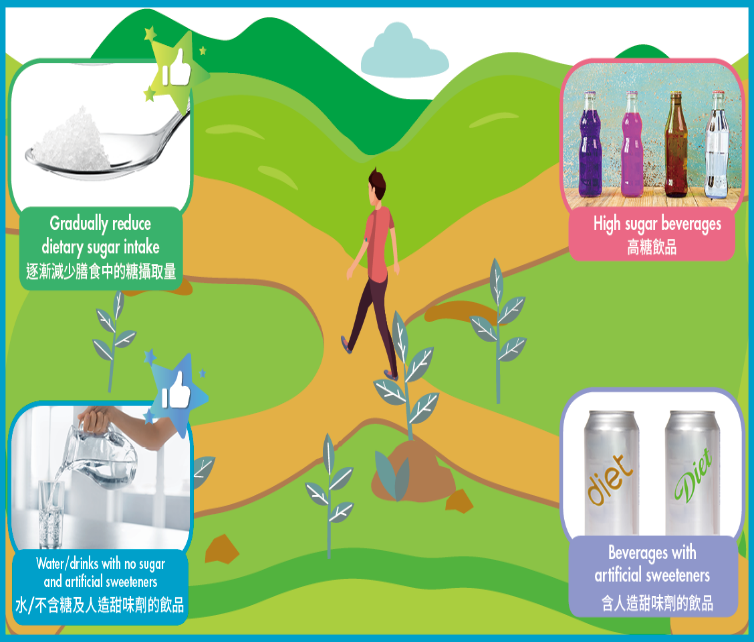
Your health is in your hands. Choose beverages with less or no sugar/ sweeteners.
Brain Gym
Multiple Choice Questions
-
Which of the following is the major cause of food poisoning in Hong Kong?
a. Physical hazards
b. Biological hazards
c. Chemical hazards
d. Radioactive hazards -
The nutrition labels of prepackaged foods contain information on energy and seven nutrients specified for labelling (1+7). Which of the following is not among the seven specified nutrients?
a. Protein
b. Sodium
c. Sugar
d. Vitamins - What is the recommended daily limit of sugar intake for an average adult?
a. 25g or about 5 cubes of table sugar
b. 40g or about 8 cubes of table sugar
c. 50g or about 10 cubes of table sugar
d. 75g or about 15 cubes of table sugar
Ans
- b
- d
- c
Enquiries and Subscription
Printed copies of the Food Safety Bulletin can be obtained from the Communication Resource Unit at Room 401, 4/F, Food and Environmental Hygiene Department Nam Cheong Offices and Vehicle Depot, 87 Yen Chow Street West, Sham Shui Po, Kowloon. For enquiries, please call 2381 6096.


